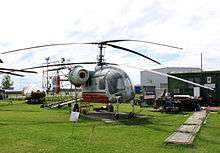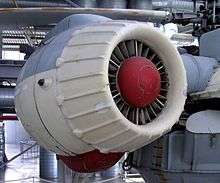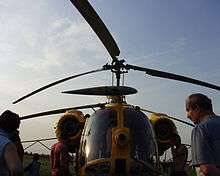Kamov Ka-26
The Kamov Ka-26 (NATO reporting name Hoodlum) is a Soviet light utility helicopter with co-axial rotors.
| Ka-26 | |
|---|---|
.jpg) | |
| A Kamov Ka-26 in flight | |
| Role | Light utility |
| Manufacturer | Kamov |
| First flight | 18 August 1965 |
| Introduction | 1969 |
| Status | Active; out of production |
| Produced | 1968–1985 |
| Number built | 816 |
| Developed into | Kamov Ka-126 Kamov Ka-226 |
Development
The Ka-26 entered production in 1969. 816 have been built. A variant with a single turboshaft engine is the Ka-126. A twin turboshaft-powered version is the Ka-226. (All the Ka-26/126/128/226 variants are code-named by NATO as "Hoodlum").
Design
The fuselage of the Ka-26 consists of a fixed, bubble-shaped cockpit containing the pilot and co-pilot, plus a removable, variable box available in medevac, passenger-carrying and crop duster versions. The helicopter can fly with or without the box attached for flexibility.
It is powered by two 325 hp (239 kW) Vedeneyev M-14V-26 radial engines mounted in outboard nacelles.
The Ka-26 is small enough to land on a large truck bed. The reciprocating engines are more responsive than turboshaft engines, but require more maintenance. It runs mostly at 95% power in crop dusting with usually excess payload, leaving little reserve power for emergencies. Due to frequent overloads, the interconnect shaft joining the two engines is prone to breakage and requires frequent inspection.
The standard instrumentation of the Ka-26, like larger naval Kamovs, may be overkill for civilian or crop dusting use. The 18-dials cockpit panel masks a part of the right-downwards view, needed to avoid telephone and power lines at low altitudes. The instrument panel may be simplified to retain the six main dials. As there is a low rotor clearance at the aircraft front, it is approached from the rear when the rotors are turning.
Due to the limitations of the Ka-26, USSR and Romania agreed under the Comecon trade to build a single-turboshaft engine version, the Kamov Ka-126, with better aerodynamics and range.
Operational history
The Ka-26 was used by some Warsaw Pact armies in the light paratroop or airborne role, but its slow (150 km/h) cruise speed compared with the Mil-2 (220 km/h) limits its military use. However, its shorter length (7.75 m) compared with the Mil Mi-2 (11.9 m) and smaller rotor diameter (13 m vs. 14.6 m) are advantageous when operating in an urban area. It has a longer range than the Mil-2 as well. The Ka-26 is eminently useful for crop dusting. The coaxial main rotor configuration, which makes the Ka-26 small and agile, also results in a delicate airflow pattern under the helicopter, providing a thorough, yet mild distribution of chemicals onto plants. The Ka-26 is often used to spray grape farms in Hungary, where conventional "main rotor and tail rotor" layout helicopters would damage or up-root the vine-stocks with their powerful airflow. Hungarian Kamov operators claim that coaxial rotors of the Ka-26 creates an airflow which allows pesticides to settle underneath, rather than on top of, the leaves, this means a much more effective distribution of pesticides, as most pests and parasites do not live on the top side of foliage. Additionally, the coaxial vortex system is symmetrical, allowing the distribution of the pesticide to be more uniform.
Variants
- Ka-26 Hoodlum-A
- One- or two-crew utility light helicopter, powered by two 325-hp (239-kW) VMK (Vedeneyev) M-14V-26 radial engines. 850 built.
- Ka-26SS
- NOTAR technology testbed for the Ka-118 fitted with tail jet beams.
- Ka-126 Hoodlum-B
- One- or two-crew utility light helicopter, powered by one 720-shp (537-kW) OMKB "Mars" (Glushenkov) TVD-100 turboshaft engine. First flown in 1986, built and developed by Industria Aeronautică Română in Romania. 2 prototypes and 15 series helicopter built.
- V-60
- A prototype light armed escort helicopter based on the Ka-126.
- Ka-128
- One prototype, powered by a 722-shp (538-kW) Turbomeca Arriel 1D1 turboshaft engine.
- Kamov Ka-226
- Six- or seven-seat utility helicopter, powered by two 450-shp (335-kW) Rolls-Royce (Allison ) 250-C20R/2 turboshaft engines.
Operators
-_by-RaBoe_01.jpg)
- West Copter [2]
Former operators

Specifications (Ka-26)


Data from Jane's All The World's Aircraft 1982–83 [10]
General characteristics
- Crew: 1 (optionally 2)
- Capacity: 6 or 7 pax when passenger module fitted / 2 stretcher patients, 2 seated patients and medical attendant / 900 kg (1,984 lb) pax or liquid chemical / 1,065 kg (2,348 lb) dusting or with platform / 1,100 kg (2,425 lb) with slung load
- Length: 7.75 m (25 ft 5 in) fuselage
- Width: 3.64 m (11 ft 11 in) over engine pods
- Height: 4.05 m (13 ft 3 in)
- Empty weight: 1,950 kg (4,299 lb) sans passenger pod / platform / agricultural equipment
- Gross weight: 3,076 kg (6,781 lb) passenger version
- 2,980 kg (6,570 lb) other versions
- Max takeoff weight: 3,250 kg (7,165 lb)
- Fuel capacity: 360 kg (794 lb) with pax ; 100 kg (220 lb) agricultural
- Powerplant: 2 × Vedeneyev M-14V-26 9-cylinder air-cooled radial piston engines, 242.5 kW (325.2 hp) each
- Main rotor diameter: 2× 13 m (42 ft 8 in)
Performance
- Maximum speed: 170 km/h (110 mph, 92 kn)
- Cruise speed: 150 km/h (93 mph, 81 kn) max
- 90–110 km/h (56–68 mph; 49–59 kn) economical
- Agricultural operating speed: 30–115 km/h (19–71 mph; 16–62 kn)
- Range: 400 km (250 mi, 220 nmi) with 7 pax,30 minutes reserve
- Ferry range: 1,200 km (750 mi, 650 nmi) with auxiliary fuel tanks
- Endurance: 3 hours 42 minutes at 90–110 km/h (56–68 mph; 49–59 kn)
- Service ceiling: 3,000 m (9,800 ft)
- Service ceiling one engine inoperative: 500 m (1,640 ft)
- Hover ceiling IGE: 1,300 m (4,265 ft) at 3,000 kg (6,614 lb) AUW
- Hover ceiling OGE: 800 m (2,625 ft) at 3,000 kg (6,614 lb) AUW
- Disk loading: 12 kg/m2 (2.5 lb/sq ft)
- Power/mass: 0.150 kW/kg (0.091 hp/lb)
See also
Related development
Aircraft of comparable role, configuration and era
References
- "Gazpromavia – fleet". gazpromavia.ru. Retrieved 10 March 2013.
- "West Copter "about us"". westcopter.ro. Retrieved 10 March 2013.
- "World Air Forces 1987 pg. 44". flightglobal.com. Retrieved 10 March 2013.
- "Bulgarski voennovazdushni sili Ka-26". Retrieved 10 March 2013.
- World Air Forces – Historical Listings Mongolia (MON) Archived 2012-09-05 at the Wayback Machine. worldairforces.com. Retrieved on 2013-08-27.
- "Valstybes Sienos Apsaugos TarnybaLa-26". Retrieved 10 March 2013.
- "World's Air Forces 1981 pg. 346". flightglobal.com. Retrieved 10 March 2013.
- "Magyar Légiero Ka-26". Retrieved 10 March 2013.
- "Kamov Ka-26 in Sri Lanka Air Force". Retrieved 16 October 2016.
- Taylor 1982, pp. 204–205.
- Taylor, John W. R. Jane's All The World's Aircraft 1982–83. London:Jane's Yearbooks, 1982. ISBN 0-7106-0748-2.
External links
| Wikimedia Commons has media related to Kamov Ka-26. |